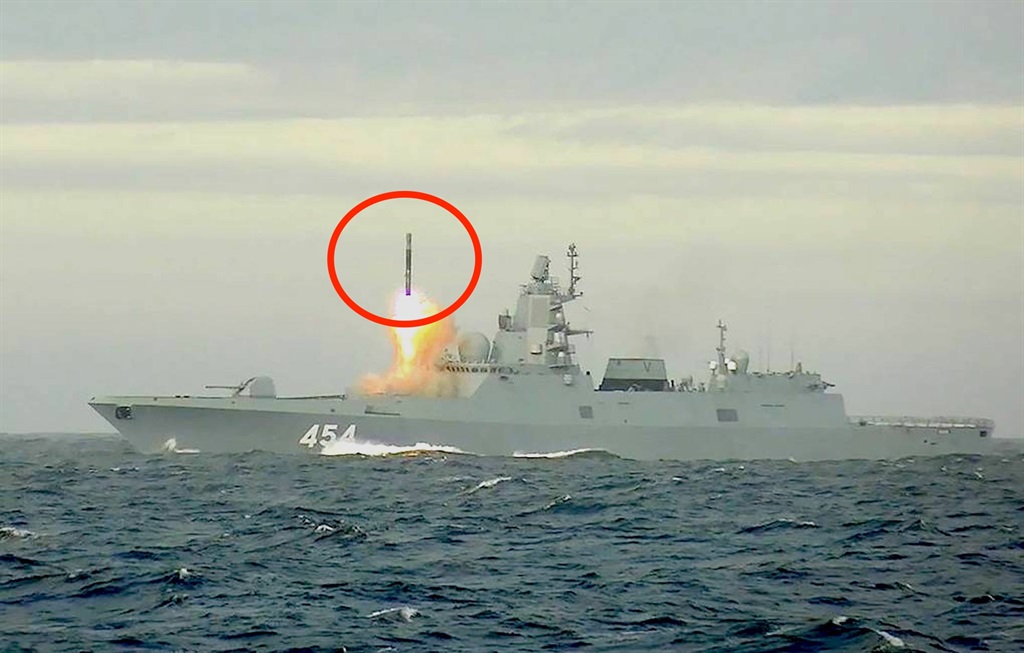News
SA is about to be in the middle of a Russian propaganda coup around an ‘unstoppable’ weapon

The Admiral Gorshkov rest-firing a missile. (Russian Ministry of Defence)
News analysis
- Russian state media is floating the prospect that Russia will test-fire a hypersonic Zircon missile during Exercise Mosi II.
- That is the joint exercise with China and Russia that SA is due to host this month, off KwaZulu-Natal.
- The Zircon could be effectively unstoppable, and Vladimir Putin has used it as an example of Russian might.
- It has never been observed in action up close by other nations, so China and South Africa will act as guarantors of sorts that it performs as advertised.
- For more stories, go to www.BusinessInsider.co.za.
For 10 days starting on 17 February, the navies of China, Russia, and South Africa are due to conduct what is formally known as Exercise Mosi II off the KwaZulu-Natal coast.
That is, in itself, controversial, “tantamount to a declaration that South Africa is joining the war against Ukraine on Russia’s side” according to the Desmond and Leah Tutu Foundation.
But the exercise now seems due to become an event of some historic significance, with a very specific role for South Africa in what is gearing up to be a propaganda coup for Russia: the unveiling of a weapon that dramatically changes the balance of power in maritime battles and atomic warfare.
During Mosi II, the Russian frigate Admiral Gorshkov will launch a Zircon missile, the state-owned Tass agency reported, based on an anonymous military source that it was “unable to officially” corroborate.
The launch, during a joint operation, would be a first of its kind, that source highlighted.
See also | If SA is taking sides in an economic war, it has chosen R16 billion over R1.131 trillion in trade
The Zircon, sometimes translated as Tsirkon, is a hypersonic missile, a class being furiously developed by China, France, and the United States among others. With speeds that Russia claims can hit Mach 9, the weapon could be effectively unstoppable if correctly deployed, making any ship (say a vastly expensive and strategically stupidly important aircraft carrier) a sitting duck. And if the claimed range of the Ziron is accurate, such a capital ship could be destroyed by an enemy as far away as Durban is from Cape Town.
Like all its major characteristics, just how far and fast a Zircon can fly is not clear, just as it is not entirely certain that Russia was the first nation to use a hypersonic missile in anger last year, in its Ukraine war – because it has never been independently observed in action. Until now, the only evidence of its use has been low-quality video released by Russia’s ministry of defence.
Now China and South Africa may be given the chance to see it up close, in full view of South African tracking apparatus and data-gathering machiner. After which, if history is any guide, the three countries will issue a joint statement capturing the highlights of the exercise. At which point SA will become a guarantor of sorts that, yes, Russia really has deployed hypersonic missiles and, yes, they really do perform as advertised.
Propaganda device meets weapon
When the Admiral Gorshkov set sail in January, Russian President Vladimir Putin spoke of how the Tsirkon “will reliably protect Russia from potential external threats and will help ensure the national interests of our country”.
In 2018, Putin pointedly described hypersonic missiles as “invincible”. He has been highly visible at every step of the Zircon’s development, culminating in its operational deployment this year, in what has been described as a matter of national pride for several nations, akin to the race to reach the Moon.
The weapon has been described as “terrifying” in the popular press in Nato countries, and in some ways it is intended to be exactly that; Putin has expressly described hypersonic missiles as a way to defeat the anti-missile systems that had the potential of neutralising Russia’s nuclear deterrent. Give it a nuclear payload, and put it on a submarine or ship in international waters, and only a sliver right in the middle of America will be safe from nuclear annihilation.
In Europe, there will be nowhere to hide.
The perception of the capabilities of the Zircon could drive foreign and military policy in Western countries, analysts have suggested.
And South Africa may just be about to become an important source of information on those capabilities.
